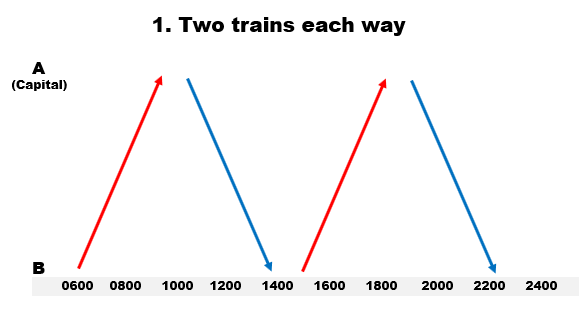However it is actually very significant. It is not often enough remarked that the number of travel options increases exponentially with frequency. Here's some examples based on hypothetical regional rail timetables.
2 trips / day trip one end
The diagram below is a train graph as often used by schedulers. 24 hour time is across the bottom (x-axis) with location being the y axis. B is a hypothetical regional city while A is the capital. Each line is a scheduled train service going in the direction shown by its arrow. Each trip takes about 3 hours. If you were able to make the train faster the line slopes would be steeper. Rail planners often refer to trains from B to A as 'up' and those from A to B as 'down'.
Some people might be content to leave things there. This is not good enough. The timetable might be operationally efficient but is still poor if it doesn't meet community needs, eg allow convenient day trips.
The above timetable works for that purpose for someone living in B wishing to spend a day in the capital A. Provided they get up early enough. In theory they could spend just an hour in A but this is unlikely given the length of the trip. Hence only one of the two scheduled return trips is useful. The same can be said for the afternoon trip to A since the choice is either stay an hour or stay overnight. Consequently for day trips from B to A only two out of four trips in the timetable are really useful. Also those in B wishing to use the train will almost certainly have to make their way to and from the station as local buses are unlikely to be still running at the time the first train departs and the last train arrives.
How useful is the timetable for those in A travelling to B for the day? Unfortunately it's not. Whereas people in B can have a long day trip to A, those in A cannot in B. Their only option is a 1 hour visit in the middle of the day. Hence this timetable might be good for B residents but is poor for businesses in B who might otherwise benefit from their town being accessible for day trippers.
2 trips / day trip both ends
You could fix the latter by adjusting the first down train so it departed A about 2 hours earlier, reaching B around midday. Departing the second up train 2 hours later completes the picture. Instead of an unusable 1 hour in B those from A can spend a much more useful 5 hours. If the last down train had catering then that could look after evening meal requirements. The trade-off with rescheduling these trains is that those in B lose the ability to spend 1 hour in A but this is probably no big loss.
The other thing that would need to change is train scheduling - rather than a full use of one train this timetable relies on part-time use of two trains with interlining likely required. The midday 5 hour dwell at location B is another inefficiency, especially if B is a rail terminus with no other line to interline with. Accepting this means accepting poor asset utilisation and lower than possible patronage from the network.
3 trips / more options
The gains for those visiting B (eg Melburnians making day trips) is less. They retain their ability to make a day trip with a little more time. However they can't make useful half-day trips. This is because efficient train turnarounds at B mean that two out of their theoretical three options are impractically short for a day trip, although some multi-day travellers would still benefit.
4 trips / even more options
Below shows a fourth trip added each way. The gaps between trains are uneven as I haven't shuffled the existing trips. To add it you may need extra trains and (certainly) at least an extra passing loop (about an hour from B) where trains cross if there is only one track.
5 trips / filling the gaps
This timetable adds a late morning trip from A to B, allowing an (almost) half-day stay. Although 2 hours is still a short time away for those making a 3 hour train trip, it still allows those in B to make a quick trip to A and be home by early afternoon. The second trip, which is formed by the last, enables those in B to make a dinner appointment in A. And if they are not too long (about 2 hours) they would be able to be home that evening on the last down train.
Adding one more trip each way transforms this. An early trip from A gives an option of an early morning arrival. And, possibly more popular, a late trip from B enables an evening meal there with an arrival at A at around midnight. Neither may not be the most popular trip in the schedule but they add a much wider range of times that adds flexibility, again multiplying the trip combinations possible.
Conclusion
I've discussed six hypothetical regional rail timetables. They show that adding trips multiplies the number of travel combinations and thus greatly increases the range of trips possible. In many cases higher frequency makes the network less Melbourne-centric as well-timed additional services can facilitate regional tourism. The best thing you can do to boost rail patronage is to do what you can to run the trains you have more frequently and thus harness the power of frequency.
In the current state election campaign we've seen pledges for increased V/Line frequency from both major parties. These include promises from Labor for major weekend frequency upgrades and the Coalition for an extra morning service from Sale.
Index to Timetable Tuesday items here







No comments:
Post a Comment